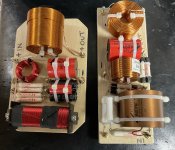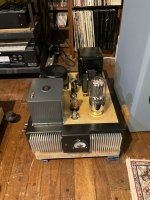Unfortunately, not only are the Metric and USA R-values not equivalent, they don't seem to relate well to fill weight.weltersys:
Well, I'm left a little curious: on his website, Joe recommends 1" and 3" thicknesses of low density damping material (and specifically recommends Bradford polymax, which seems to be unavailable in my corner of the world). If one were to use R-19 insulation, would it be necessary to cut the material into 3" thick sheets, or is the R-19 insulation (as is) roughly equivalent to 3" of low density damping material?
And fill weight does not equal the same acoustical absorption coefficients from different material.
The diameter of the fill material fiber and matrix all can result in quite different absorption at different frequencies.
https://www.bobgolds.com/AbsorptionCoefficients.htm
Joe measured the 180mm Bradford Polymax he's using at around 14-15g per Litre density, while the Bradford Gold 185mm fiberglass is only 7g per litre:
The USA "R-19" fiberglass batts at around 6.25-6.5" are ~27-31g per liter (.44 pound per cubic foot).
At any rate, I didn't even know Joe's speakers were ported before yesterday, if you fill them with 50 liters of fiberglass, the port might as well be sealed
http://sound-au.com/articles/boxstuff.htm
With a rear mounted port, the upper pipe resonance peak in the combined response seen in Rod Elliott's test above is usually not much of a problem, don't go overboard with damping material...
Art
oe, any news regarding publication of the NBAC version? 🙂
Yes. sorry about the delay. It has come down to the battle of the tweeters. Steve originally was the reason I went down the NBAC route and use the ceramic coated tweeter. But I have lately been working on a 2-Way loudspeaker (not DIY) and using the silk dome tweeter and the results I got were so pleasing. So I made a decision to try that with the NBAC drivers. There was a subtlety I was getting that I liked very much. The good news is that I am well along doing that, the Crossovers have been built and I now need to change the tweeters and waveguides and then make it work. I do not think that will be hard or take too much time. I have also been dealing with a few health issues, but that situ is much better now.
So not too far away now...
Good to hear.but that situ is much better now.
Hello Joe,I know that a number of you reading this already know. That when Covid broke out in early 2020 I was dealing with something else that made Covid a walk in the park. Nothing in my life could have prepared me for this. The three Covid years happen to coincide with my son's condition, which is incurable but turned out in the end to be treatable, and now he is much better; he has a disability pension as a safety net, and since early this year has stabilised with medication and have been able to take up steady work this year. Those three years can only be described as harrowing! I also learned that this is far more common than most realise and that health services are very flawed and often made a bad situation worse. Despite this, I have still been active in audio and kept my business alive, just. A number of projects/jobs for private clients were fulfilled. As for that paper, it is coming along nicely and will feature a novel test that was conceived in March earlier this year. It will surprise a lot of people and force them to start measuring something that they are not doing, the effect that the driver has on the amplifier when the latter is a voltage source, it is supposed to behave one way except it does not. We must measure both voltage and current of the amplifier and this novel test will show why that is the case. It will be thoroughly proof read and reviewed by very knowledgeable persons before becoming released. There will be no fanfare here. Enuff said.
Status report?
Finally getting everything in hand to start on a ULD Elsinore build after a couple of months waiting on drivers. I have two packages from PURIFI coming tomorrow (finally!) with the 8 drivers, the crossovers are already built, and have wood in hand. BTW, I am using 1” thick bamboo plywood countertop for the top, back and sides with some 3/4” bamboo plywood for the baffle and plywood or plywood/MDF laminate for the bracing. All in all, not that much more expensive than BB plywood. I still have a couple pairs of 211 SET amplifiers to finish for friends/clients, but after those are finished, I can begin on the Elsinores. Progress reports in a couple of months (hopefully).
Last edited:
Well, I do have a pic of the crossover boards. I decided to separate the crossover into two boards, one for the tweeter and upper mid-bass drivers that will be mounted between the braces on the back panel, and the one for the lower two mid-bass drivers to be mounted at the cabinet bottom.
The 211 amps that are keeping me from starting on the ULD Elsinores is shown in this gratuitous photo, next to my first Elsinore build. It is a Class A2 25W 211 SET of my own design with Tamura output transformers, D3A CCS loaded input, direct coupled EL34 pentode follower driving the 211 grid. I built one pair as a one-off, but people who hear them keep asking me to build a pair for them, so on pairs 4 and 5 right now (I did sneak a pair in for myself). I really need to put together a construction article on the design and build. But not in this thread or forum.
The 211 amps that are keeping me from starting on the ULD Elsinores is shown in this gratuitous photo, next to my first Elsinore build. It is a Class A2 25W 211 SET of my own design with Tamura output transformers, D3A CCS loaded input, direct coupled EL34 pentode follower driving the 211 grid. I built one pair as a one-off, but people who hear them keep asking me to build a pair for them, so on pairs 4 and 5 right now (I did sneak a pair in for myself). I really need to put together a construction article on the design and build. But not in this thread or forum.
Attachments
Last edited:
Elsinores, of course. It seems these amps and these speakers are an incredible sounding combination, they really completely disappear so that music is just present in the room and one is emotionally drawn into it. The Elsinores are really easy to drive (flat impedance curve) and work great with a 20W amp.
- Home
- Loudspeakers
- Multi-Way
- The "Elsinore Project" Thread

